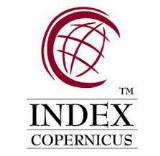
Clinical features and characteristics of myocardial injure in COVID-19 (data from multicenter studies
Research article: Clinical features and characteristics of myocardial injure in COVID-19 (data from multicenter studies)
Authors: T.M. Cavadova*, G.M. Dadashova, M.N. Azimova, N.N. Qabiyeva
Scientific Research Institute of Cardiology named after academician J. Abdullayev; 85 Fatali Khan Xoyski Str., Baku AZ1072, Azerbaijan
*For correspondence: tmagayeva@gmail.com
Received 21 November 2020; Received in revised form 31 November 2020; Accepted 01 December 2020
Abstract:
In patients with COVID-19 caused by coronavirus-2 (SARS-CoV-2) and proceeding with the severe acute respiratory syndrome, studies were carried out to study myocardial damage, determine its na- ture and clinical significance. In an international, multicenter study, cardiovascular pathologists as- sessed cardiac tissue after necropsies in 21 COVID-19 patients. The presence of myocarditis was determined by the identification of multiple foci of inflammation with associated damage to myocytes, and the composition of the inflammatory cells was analyzed using immunohistochemistry. Other forms of acute damage and inflammation of myocytes, as well as damage to the coronary arteries, endocardium and pericardium, have also been described. Lymphocytic myocarditis occurred in 3 (14%) cases. Increased infiltration of interstitial macrophages was observed in 18 (86%) cases. In four cases, there was mild pericarditis. Acute damage to right ventricular myocytes, most likely due to stress/overload, occurred in four cases. In COVID-19, myocardial damage has been reported, in- cluding elevated serum troponin levels and acute heart failure with decreased ejection fraction. There was a slight trend towards higher serum troponin levels in patients with myocarditis compared with patients without myocarditis. With SARS-CoV-2, interstitial macrophages increase in most cases, and in a small proportion of cases, multifocal lymphocytic myocarditis. Other forms of myocardial injury may also occur. The risk of hospital death among patients with severe COVID-19 can be pre- dicted from markers of myocardial damage and has been significantly associated with older age, inflammatory response, and concomitant cardiovascular disease.
Keywords: Coronavirus Disease 2019 (COVID-19), SARS-CoV-2, myocardial injury, myocarditis, lactate dehydrogenase, cardiac troponin I, creatine kinase (-MB), myoglobin
References
Anuradha L., Kipp W.J., James L., Januzzi Russak A.J., Paranjpe I., Richteet F. et al. (2020) Prevalence and impact of myocardial in-jury in patients hospitalized with COVID-19 in-fection. J. Am.Coll.Cardiol., 76(5): 533–546.
Chen L., Li X., Chen M., Feng Y., Xiong C. (2020) The ACE2 expression in human heart in-dicates new potential mechanism of heart injury among patients infected with SARS-CoV-2. Car-diovasc. Res., 116: 1097-1100.
Chen T., Wu D., Chen H., Yan W., Yang D., Chen G., Ma K., Xu D., Yu H., Wang H., Wang T., Guo W., Chen J., Ding C., Zhang X., Huang J., Han M., Li S., Luo X., Zhao J., Ning Q. (2020) Clinical characteristics of 113 de-ceased patients with coronavirus disease 2019: retrospective study. BMJ, 368: m1091.
Corrales-Medina V.F., Musher D.M., Shach-kina S., Chirinos J.A. (2013) Acute pneumonia and the cardiovascular system. Lancet, 381: 496–505.
Corrales-Medina V.F., Musher D.M., Wells G.A., Chirinos J.A., Chen L., Fine M.J. (2012) Cardiac complications in patients with commu-nity-acquired pneumonia: incidence, timing, risk factors, and association with short-term mortal-ity. Circulation, 125: 773–781.
Davidson J.A., Warren-Gash C. (2019) Cardio-vascular complications of acute respiratory infec-tions: Current research and future directions. Ex-pert Rev. Anti-Infect. Ther., 17: 939-942.
Du R.H., Liang L.R., Yang C.Q. Wang W. Cao T-Z., Li. M., Guo G-Y., Du J., Zheng C-L., Zhu Q., Hu M., Li X-Y., Peng P., Shi H-Z. (2020) Predictors of mortality for patients with COVID-19 pneumonia caused by SARSCoV-2: A prospective cohort study. Eur. Respir. J., 55: 2000524.
Fauci A.S., Lane H.C., Redfield R.R. (2020) Covid-19 – navigating the uncharted. N. Engl. J. Med., 382: 1268-1269.
Gallagher P.E., Ferrario C.M., Tallant E.A. (2008) Regulation of ACE2 in cardiac myocytes and fibroblasts. Am. J. Physiol. Heart Circ. Phys-iol., 295: H2373-H2379.
Gaze D.C. (2020) Clinical utility of cardiac tro-ponin measurement in COVID-19 infection. Ann. Clin. Biochem., 57: 202-205.
Guan W.J., Ni Z.Y., Hu Y., Liang W.H., Ou C.Q., He J.X., Liu L., Shan H., Lei C.L., Hui D.S., Du B., Li L.J., Zeng G., Yuen K.Y., Chen R.C., Tang C.L., Wang T., Chen P.Y., Xiang J., Li S.Y., Wang J.L., Liang Z.J., Peng Y.X., Wei L., Liu Y., Hu Y.H., Peng P., Wang J.M., Liu J.Y., Chen Z., Li G., Zheng Z.J., Qiu S.Q., Luo J., Ye C.J., Zhu S.Y., Zhong N.S. (2019) For the China Medical Treatment Expert Group for Covid-19. Clinical characteristics of corona-virus disease in China. N. Engl. J. Med., 382:1708-1720. doi:10.1056/NEJMoa2002032.
Han H., Xie L., Liu R., Yang J., Liu F., Wu K., Chen L., Wei H., Yong F., Zhu C. (2020) Analysis of heart injury laboratory parame-ters in 273 COVID-19 patients in one hospital in Wuhan, China. J. Med. Virol., 92: 819-823.
Hoffmann M., Kleine-Weber H., Schroeder S. Krüger N., Herrler T., Erichsen S., Schiergens T., Herrler G., Wu N., Nitsche A., Müller M., Drosten C., Pöhlmann S. (2020) SARS-CoV-2 cell entry depends on ACE2 and TMPRSS2 and is blocked by a clinically proven protease inhibitor. Cell, 181: 271-280.e8.
Huang C., Wang Y., Li X., Ren L., Zhao J., Hu Y., Zhang L., Fan G., Xu J., Gu X., Cheng Z., Yu T., Xia J., Wei Y., Wu W., Xie X., Yin W., Li H., Liu M., Xiao Y., Gao H., Guo L., Xie J., Wang G., Jiang R., Gao Z., Jin Q., Wang J., Cao B. (2020) Clinical features of patients in-fected with 2019 novel coronavirus in Wuhan, China. Lancet, 395: 497–506.
Huang K., Wang Y., Li X. , Ren L., Zhao J., Hu Y., Zhang L., Fan G., Xu J., Gu X., Cheng Z., Yu T., Xia J., Wei Y., Wu W., Xie X., Yin W., Li H., Liu M., Xiao Y., Gao H., Guo L. et al. (2020) Clinical features of 2019 new coro-navirus patients in Wuhan, China. Lancet, 395: 497-506.
Ji D., Zhang D., Xu J. et al. (2020) Prediction for progression risk in patients with COVID-19 pneu-monia: The CALL Score. Clin. Infect. Dis., 71(6): 1393-1399. doi: 10.1093/cid/ciaa414.
Jing Z.C., Zhu H.D., Yan X.W., Chai W.Z., Zhang S. (2020) Recommendations from the Pe-king Union Medical College Hospital for the man-agement of acute myocardial infarction during the COVID-19 outbreak. Eurş Heart J., 41(19): 1791-1794. doi:10.1093/eurheartj/ehaa258.
Li S.S., Cheng C.W., Fu C.L., Chan Y.H., Lee M.P., Chan J.W., Yiu S.F. (2003) Left ventric-ular performance in patients with severe acute respiratory syndrome: a 30-day echocardio-graphic follow-up study. Circulation, 108: 1798-1803.
Lo I.L., Lio C.F., Cheong H.H., Lei C.I., Cheong T.H., Zhong X., Tian Y. and Sin N.N. (2020). Evaluation of SARS-CoV-2 RNA shedding in clinical specimens and clinical characteristics of 10 patients with COVID-19 in Macau. Int. J. Biol. Sci., 16: 1698-1707.
Madjid M., Safavi-Naeini P., Solomon S.D. Var-deny O. (2020) Potential effects of coronaviruses on the cardiovascular system: A review. JAMA Cardiol., 5(7): 831-840. doi: 10.1001/jamacar-dio.1286.
Mo P., Xing Y., Xiao Y. Deng L., Zhao Q., Wang H., Xiong Y., Cheng Z., Gao S., Liang K., Luo M., Chen T., Song S., Ma Z., Chen X., Zheng R., Cao Q., Wang F., Zhang Y. (2020) Clinical characteristics of refractory COVID-19 pneumonia in Wuhan, China. Clin. Infect. Dis., ciaa270; doi: 10.1093/cid/ciaa270.
Oudit G.Y., Kassiri Z., Jiang C., Liu P.P., Poutanen S.M., Penninger J.M., Butany J. (2009) SARS coronavirus modulation of myocar-dial ACE2 expression and inflammation in pa-tients with SARS. Eur. J. Clin. Invest., 39: 618–625.
Ramirez J., Aliberti S., Mirsaeidi M., Peyrani P., Filardo G., Amir A., Moffett B., Gordon J., Blasi F., Bordon J. (2008) Acute myocardial in-farction in hospitalized patients with community-acquired pneumonia. Clin. Infect. Dis., 47: 182–187.
Ranieri V.M., Rubenfeld G.D., Thompson B.T., Ferguson N.D., Caldwell E., Fan E., Campo-rota L., Slutsky A.S. (2012) Target group for the definition of ARDS, ARDS Definition Working Group. Acute Respiratory Distress Syndrome: A Berlin Definition. JAMA, 307: 2526-2533.
Ruan Q., Yang K., Wang W., Jiang L., Song J. (2020) Clinical predictors of mortality due to COVID-19 based on an analysis of data of 150 patients from Wuhan, China. Intensive Care Med., 46: 1294-1297.
Shi S., Qin M., Shen B., Cai Y., Liu T., Yang F., Gong W., Liu X., Liang J., Zhao Q., Huang H., Yang B., Huang C. (2020) Association of cardiac injury with mortality in hospitalized pa-tients with COVID-19 in Wuhan, China. JAMA Cardiol., 5: 802–810.
Smeeth L., Thomas S.L., Hall A.J. Hubbard R., Farrington P. and Vallance P. (2004) Risk of myocardial infarction and stroke after acute infection or vaccination. N. Engl. J. Med., 351: 2611-2618.
Thygesen K., Alpert J.S., Jaffe A.S., Chaitman B.R., Bax J.J., Morrow D.A. (2019) White HD; ESC Scientific Document Group. Fourth univer-sal definition of myocardial infarction (2018) Eur. Heart J., 40: 237–269.
Tikellis C., Thomas M.C. (2012) Angiotensin-converting enzyme 2 (ACE2) is a key modulator of the renin angiotensin system in health and dis-ease. Int. J. Pept., 2012: 256294.
Wan S., Xiang Y., Fang W., Zheng Y., Li B., Hu Y., Lang C., Huang D., Sun Q., Xiong Y., Huang X., Lv J., Luo Y., Shen L. Yang H., Huang G., Yang R. (2020) Clinical features and treatment of COVID-19 patients in northeast Chongqing. J. Med. Virol., 92: 797-806.
Wang D., Hu B., Hu C., Zhu F., Liu X., Zhang J., Wang B., Xiang H., Cheng Z., Xiong Y., Zhao Y., Li Y., Wang X., Peng Z. (2020) Clinical char-acteristics of 138 hospitalized patients with 2019 novel coronavirus-infected pneumonia in Wuhan, China. JAMA, 323: 1061–1069.
Wang L., He W., Yu X., Hu D., Bao M., Liu H., Zhou J. and Jiang H. (2020) Coronavirus disease 2019 in elderly patients: Characteristics and prognostic factors based on 4-week follow-up. J. Infect., 80: 639-645.
Wang Z., Yang B., Lee Q., Wen L., Zhang R. (2020) Clinical features of 69 coronavirus cases in Wuhan, China. Clin. Infect. Dis., 71(15): 769-777. doi: 10.1093/cid/ciaa272.
Xu Z., Shi L., Wang Y., Zhang J., Huang L., Zhang C., Liu S., Zhao P., Liu H., Zhu L., Tai Y., Bai C., Gao T., Song J., Xia P., Dong J., Zhao J., Wang F.S. (2020) Pathological findings of COVID-19 associated with acute respiratory distress syndrome. Lancet Respir. Med., 8: 420–422.
Yader S., Allan S.J. (2020) Key points about my-ocardial injury and cardiac troponin in COVID-19. American College of Cardiology, https://www.acc.org/latest-in-cardiology/articles/ 2020/07/17/08/00/key-points-about-myocardial-injury-and-cardiac-troponin-in-covid-19
Zhang H., Penninger J.M., Li Y., Zhong N., Slutsky A. (2020) Angiotensin-converting en-zyme 2 (ACE2) as a SARS-CoV-2 receptor: Mo- lecular mechanisms and potential therapeutic tar-get. Intensive Care Med., 46: 586-590.
Zhou F., Yu T., Du R., Fan G., Liu Y., Liu Z., Xiang J., Wang Y., Song B., Gu X., Guan L., Wei Y., Li H., Wu H., Xu J., Tu S., Zhang Y., Chen H.. Cao B. (2020) Clinical course and risk factors for mortality of adult inpatients with COVID-19 in Wuhan, China: a retrospective co-hort study. Lancet, 395: 1054–1062.
Zhou B., She J., Wang Y., Ma X. (2020) Clinical characteristics of myocardial injury in severe and very severe patients with 2019 novel coronavirus disease. J. Infect., 81: 147-178.
Zhu N., Zhang D., Wang W., Li X., Yang B., Song J., Zhao X., Huang B., Shi W., Lu R., Niu P., Zhan F., Ma X., Wang D., Xu W., Wu G., Gao G., Tan W. (2020) A novel coronavirus from patients with pneumonia in China 2019. N. Engl. J. Med., 382: 727–733.























